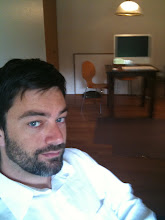Because it was noon and 90+ fricking degrees out with 40% humidity.
Still, today marked an important milestone in my post-injury recovery: The first time I slowed down because I
If you watch that video carefully, you'll notice that Carl Lewis' feet don't actually touch the ground for the entire 100M.
So Pose, is this method by a bunch of British sport scientists who are trying to make their triathletes faster and it basically involves running by falling forwards. They claim that its two main benefits are being easier on the knees and keeping your heart rate lower at the same speed. There is a lot of debate about the second claim, but as for the first claim, I can say I'm a believer. For the whole story, buy their Book or watch their Movie
or watch their Movie , but my two take-aways for knee-saving today are thus:
, but my two take-aways for knee-saving today are thus:
- Lift up with your knees. You can seemingly get a similar propulsive effect from not leaning forward as much and pushing back with your trailing foot, but this is most definitely much harder on your knee. Especially one with a torn PCL.
- Shoulders back, head up. Just like Mom said. Mostly this
is significantly more attractivemakes your body more like a plank, which means it falls forward faster and with less effort. Also helpful is that it is easier on your lungs to breath this way.








